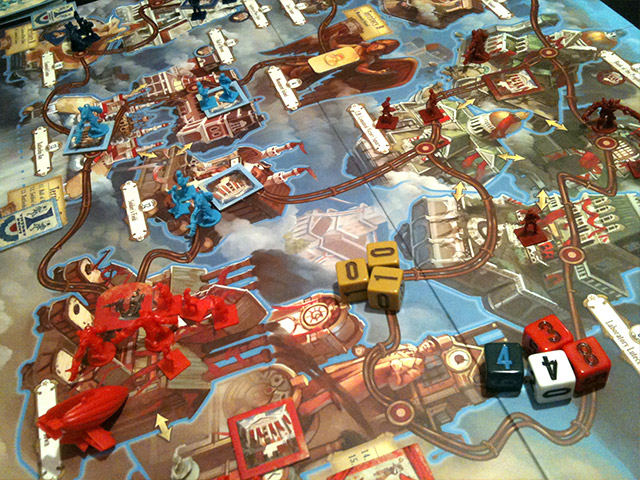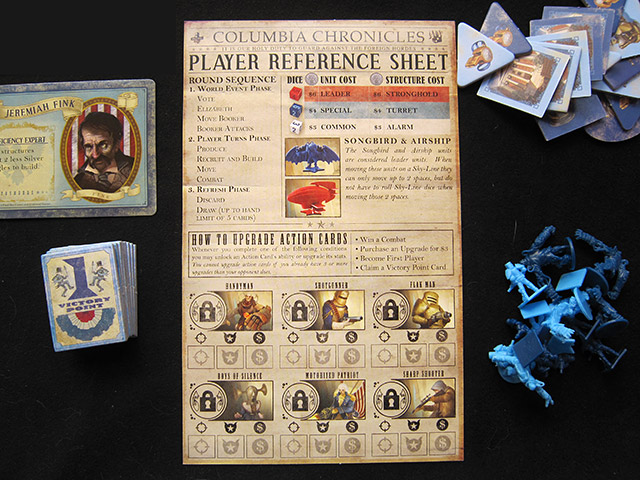
Book ’em Booker!
Join Booker and Elizabeth in a battle across the skylines in Plaid Hat’s boardgame based on Bioshock: Infinite.
 The EOG recently sat down with Plaid Hat Games to discuss the making of Bioshock Infinite: The Siege of Columbia, and we highly recommend you read that article for some insights into the process behind designing the game. But of course, what we all really want to know is … is it fun to play? Swallow your vigors and strap on your hand cannons, because we’re about to find out …
The EOG recently sat down with Plaid Hat Games to discuss the making of Bioshock Infinite: The Siege of Columbia, and we highly recommend you read that article for some insights into the process behind designing the game. But of course, what we all really want to know is … is it fun to play? Swallow your vigors and strap on your hand cannons, because we’re about to find out …
For those who completely eschew the world of computer gaming, Bioshock Infinite: The Siege of Columbia is based on the smash hit first person shooter, winner of numerous awards and widely fulsome praise. I, on the other hand—and slightly irrelevantly to this boardgame review—didn’t find it much fun. It started well, with stunning visuals and some confronting, challenging things to say about racism and American history, but rapidly degenerated into an brightly coloured shoot-’em-up with a tricksy story twist at the end. Much like in the first game in the series, Bioshock, I found the endless scrounging through drawers and trash cans for ammo and food tedious, the environments repetitive despite all the obsessive detail, and the battles with faceless adversaries uninteresting. But enough of my console-based prejudices, how is the boardgame?
Well, as has been pointed out by numerous reviewers, if you haven’t played the computer game you’ll be somewhat thrown into the deep end here theme-wise. BI:TSoC pretty much assumes you’re a fan of the original and know what’s going on, and while a boardgamer picking this up will most probably have some attachment to the theme, that could alienate the gamers who have no such previous attachment. Who are Booker and Elizabeth, where is this strange sky city, and why are the Founders and the Vox Populi at each others’ throats? What is this strange mixture of early Americana and science-fiction? How important this is will depend on your group of course, but hopefully it won’t stop anyone from enjoying the game. In my case, when we played with four, two of us knew nothing about the background, but a brief précis was enough to clue them in.

It’s a bit of a shame if you haven’t been immersed in the computer game actually, because the graphic design here captures its look and feel perfectly. This is all the more impressive an achievement considering the graphic designer was working with unfinished assets and references. Peter Wocken is that designer, and he has outdone himself in creating what I think is a vastly superior piece of work to City of Remnants. The colours pop, the fonts and imagery are carefully chosen, the decorative elements are stylistically appropriate. Yes, the board is a little busy and the borders defining areas blend into the art a bit, but this didn’t cause any difficulties once we all had a mental map of the board. This design quality is matched by component quality, and the big-numbered custom dice and little plastic units are wonderful. However I would have loved to have seen the cards just a bit thicker and with a linen finish, and Plaid Hat Games follows the usual American publisher convention of including no box insert.
Booker may also appear around Columbia, and if he happens to be in an aggressive mood he can play havoc with your forces
The rules are easy to explain and you can get started with newbies in very quick order. The game plays with either two or four players, the latter in two teams. Each game round starts with the draw of a World Event card on which players vote, totalling the influence value on cards they may choose to discard to decide whether the event passes or not. Further information on the card indicates whether special events occur concerning Elizabeth, as a counter moves down on one of three Elizabeth Timeline sheets you randomly choose at the start of the game. Booker may also appear around Columbia, and if he happens to be in an aggressive mood he can play havoc with your forces.
In the next phase players take a turn each, in which they may discard cards in exchange for Silver Eagles, the game’s currency; buy new units, build structures (strongholds, turrets and alarms to bolster your controlled areas), and purchase upgrades for their cards; move up to four units around the board, and finally engage in combat if their units end up sharing a location with enemy forces.
In the Refresh phase, players may discard cards and then draw back up to five in hand. Then a Victory Point card is drawn and added to those on the table.

Which all sounds like a pretty straightforward, dudes-on-a-map type of experience. But a few interesting systems make the game special.
… your cards are very multi-purpose, and it’s a continual juggling act deciding how to use your limited hand of cards.
For a start, victory points are gained not only by controlling territories, but by being the first to fulfil the conditions on the Victory Point cards that enter the game at the end of each turn. This can change the character of the game as players vie to be the first to grab these points, and your options for points change as more are revealed, ramping up the pace of the game. Secondly, your cards are very multi-purpose, and it’s a continual juggling act deciding how to use your limited hand of cards: do you spend their influence to pass a particularly useful event and grab the first player honours, or do you need to trade some in for cash to buy more units? And how many will you need to bolster that important combat coming up this turn?
Your cards are crucial during combat; you can play them not only to add their combat values to the different dice you roll for your units in the contested area, but they also have special abilities that can be unlocked by passing various milestones: winning a combat, getting the first player token, and claiming a victory point card. You can also just buy an upgrade. This is one part of the game where I felt the elegance fell apart slightly. You keep track of your upgrades—either unlocking those special abilities or increasing stats by up to two points—by placing counters on a sheet, and this feels bit fiddly and makes it difficult to work out your combat totals at a glance. In addition, the events that allow you to upgrade are quite common, and a rule stipulates that you cannot have more than three upgrades more than your opponent; so the mechanic feels slightly arbitrary and ‘gamey’. Players go through the motions of upgrading at roughly the same rate; whether you can really make a difference by concentrating on upgrading specific cards is something that remains to be experimented with in further plays.

One of the most distinctive features of the computer game were the ‘skylines’, looping rails used for transport between the floating suburbs of Columbia. Here they introduce a fun and unpredictable element to the usual area control battles by allowing players to push their luck and make unexpected, fast attacks into areas. Each unit that uses a skyline can move any number of stops on the route, but must roll three ‘skyline dice’ at every stop. This may mean your units make a surprise attack on an unprepared opponent—or it may mean your hand of cards is cut back ruthlessly or, worse, the larger part of your force falls ingloriously to their deaths.
Throughout this movement and conflict Booker and Elizabeth frequently shake things up, either by Booker attacking units (he also has a ‘swing vote’ in the voting step), or Elizabeth triggering special effects depending on the chosen Elizabeth Timeline sheet. These events will mean very little to gamers who haven’t played the computer game, thematically, but they certainly add variety and interest. In some cases players can gain an advantage by controlling Elizabeth when Booker isn’t around, but this is a dangerous strategy as he’ll soon be back to rescue her—and he’s a tough opponent.
I’ve played with both two players and two teams, and the game was just as fun with both configurations. One two-player game ended with a slight anti-climax when an Elizabeth event changed the winning condition from ten VP to eight, and my opponent already had eight—but I should have read ahead on the timeline and seen that coming. The team game adds some cooperation to the gameplay, but you still feel like you’re controlling your own units and destiny, with the added opportunity to work together with a teammate for the win.
The game is strategic, but of course with all the cards and dice there is a large element of luck involved, especially when you start braving skyline transport to get your forces over to those other territories. It’s a relatively light, thematic boardgame that still packs in enough variety to keep experienced gamers happy, though you can turn your brain off and just enjoy the ride if you prefer. I’ve had a far, far better time playing Bioshock Infinite: The Siege of Columbia than I did the video game on which it was based, and in fact it’s interesting to reflect on all the qualities that a boardgame can bring to a gaming experience that a video game cannot. The latter may have spectacular 3D graphics and 5.1 stereo music and sound effects, but it can’t beat the enjoyment of gathering friends around a boardgame, imagining the action and making your own whooshing noises when your units grab the skyline; not to mention real competition against real opponents who are right there at the table!